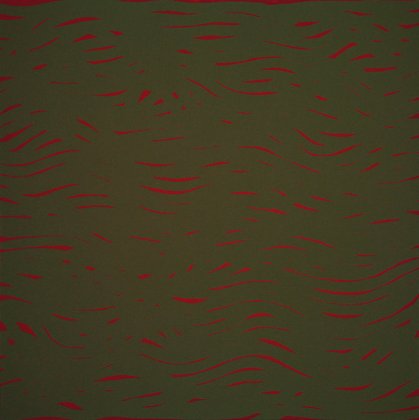RIP Sol LeWitt
Sol LeWitt, American master of conceptual art, dies at 78.
LeWitt preferred to let his work speak for itself and frequently avoided media attention.
“He never felt that art has to do with the personality of the person who made it,” Andrea Miller-Keller, a former Hartford curator and longtime friend, told The Courant. “It’s not about the star power but about the art.” (via)
Sol Lewitt 
Sol LeWitt working at Crownpoint Press studio.
Sol Lewitt on Google.
What I remember most about Sol LeWitt came from reading a biography of Eva Hesse. While Hesse was living with her husband in Germany, Sol LeWitt nourished and encouraged Eva during her days of artistic isolation They corresponded daily. He was her friend and a mentor.
Sol Lewitt 
(Digital image from this post by Fung Lin Hall 4/9/2007 – despite my penchant for gossip and annoying celebrity artist worship, I appreciated LeWitt’s avoidance of celebrity and I am grateful to Sol LeWitt for his inspirational art.)
Sentences on Conceptual Art
by Sol LeWitt
1. Conceptual artists are mystics rather than rationalists. They leap to conclusions that logic cannot reach.
2. Rational judgments repeat rational judgments.
3. Irrational judgments lead to new experience.
4. Formal art is essentially rational.
5. Irrational thoughts should be followed absolutely and logically.
6. If the artist changes his mind midway through the execution of the piece he compromises the result and repeats past results.
7. The artist’s will is secondary to the process he initiates from idea to completion. His willfulness may only be ego.
8. When words such as painting and sculpture are used, they connote a whole tradition and imply a consequent acceptance of this tradition, thus placing limitations on the artist who would be reluctant to make art that goes beyond the limitations.
9. The concept and idea are different. The former implies a general direction while the latter is the component. Ideas implement the concept.
10. Ideas can be works of art; they are in a chain of development that may eventually find some form. All ideas need not be made physical.
11. Ideas do not necessarily proceed in logical order. They may set one off in unexpected directions, but an idea must necessarily be completed in the mind before the next one is formed.
12. For each work of art that becomes physical there are many variations that do not.
13. A work of art may be understood as a conductor from the artist’s mind to the viewer’s. But it may never reach the viewer, or it may never leave the artist’s mind.
14. The words of one artist to another may induce an idea chain, if they share the same concept.
15. Since no form is intrinsically superior to another, the artist may use any form, from an expression of words (written or spoken) to physical reality, equally.
16. If words are used, and they proceed from ideas about art, then they are art and not literature; numbers are not mathematics.
17. All ideas are art if they are concerned with art and fall within the conventions of art.
18. One usually understands the art of the past by applying the convention of the present, thus misunderstanding the art of the past.
19. The conventions of art are altered by works of art.
20. Successful art changes our understanding of the conventions by altering our perceptions.
21. Perception of ideas leads to new ideas.
22. The artist cannot imagine his art, and cannot perceive it until it is complete.
23. The artist may misperceive (understand it differently from the artist) a work of art but still be set off in his own chain of thought by that misconstrual.
24. Perception is subjective.
25. The artist may not necessarily understand his own art. His perception is neither better nor worse than that of others.
26. An artist may perceive the art of others better than his own.
27. The concept of a work of art may involve the matter of the piece or the process in which it is made.
28. Once the idea of the piece is established in the artist’s mind and the final form is decided, the process is carried out blindly. There are many side effects that the artist cannot imagine. These may be used as ideas for new works.
29. The process is mechanical and should not be tampered with. It should run its course.
30. There are many elements involved in a work of art. The most important are the most obvious.
31. If an artist uses the same form in a group of works, and changes the material, one would assume the artist’s concept involved the material.
32. Banal ideas cannot be rescued by beautiful execution.
33. It is difficult to bungle a good idea.
34. When an artist learns his craft too well he makes slick art.
35. These sentences comment on art, but are not art.
Update: an email came from Janet Paparelli this morning.
I had a great little poster reproduction of a painting by Sol LeWitt once. I don’t know what became of it. There was an
expressionistically painted white background and expressionistic black letters which said: “THIS PAINTING IS NOW OUT OF STYLE”.
Janet